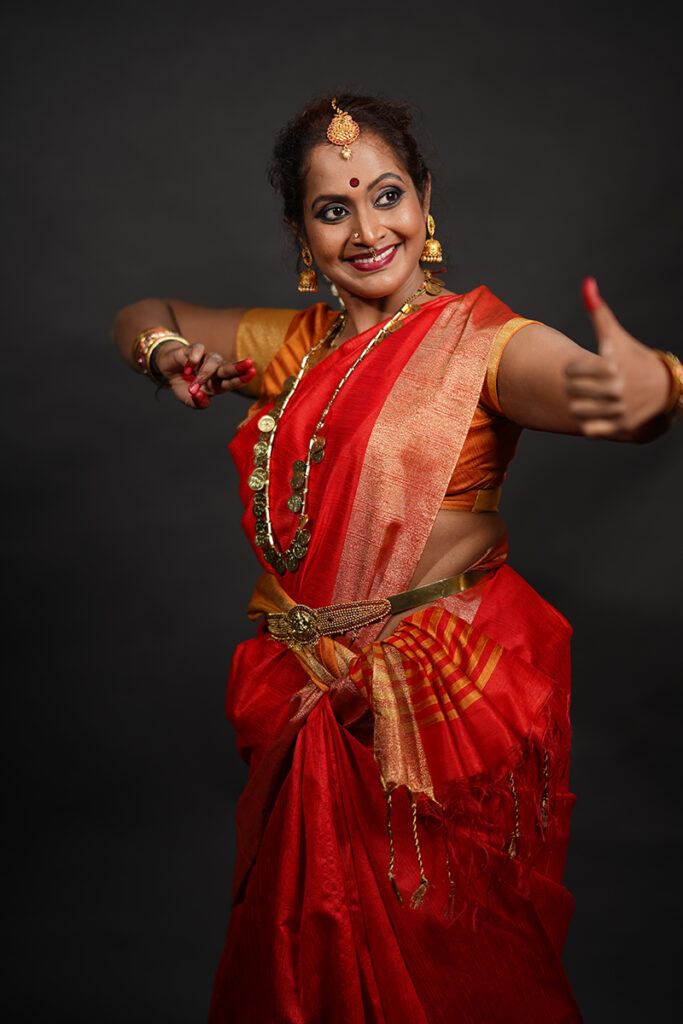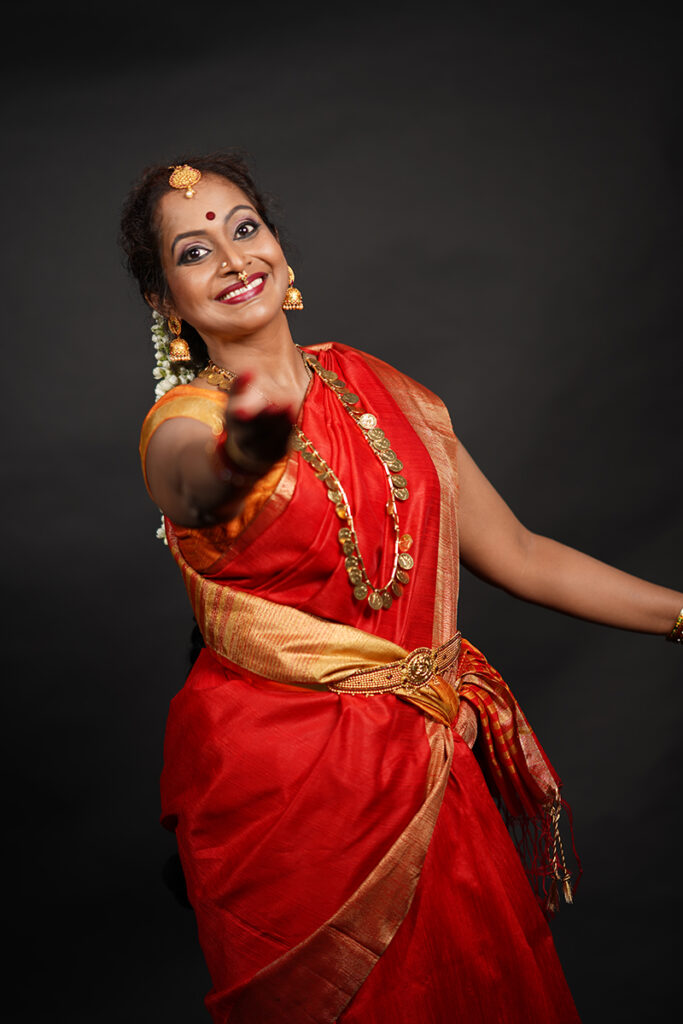Reclaiming An Invisible Woman’s Dance
An Interview with Dr. Yashoda Thakore
BY EMMALY WIEDERHOLT; PHOTOS BY SITA UDAY
Note: This essay was first published in Stance on Dance’s fall/winter 2022 print issue. To learn more, visit stanceondance.com/print-publication.
Dr. Yashoda Thakore is a Kuchipudi dancer and scholar in India whose current research focuses on the Kalavantulu, the women temple dancers from Telugu-speaking areas. Here, she describes who the Kalavantulu are, their historical significance, how they influenced Indian classical dance, and why she is trying to erase the stigma around them through education.

~~
Can you tell me a little about your dance history and what shaped who you are as an artist today?
My parents said I declared I wanted to be a dancer very early in life as a child. For me at that time, being a dancer meant being a classical dancer, even though I didn’t know what classical dance or any other dance was. I saw dance on television, which came to our city when I was about five. I would watch Bharatanatyam and I would say, “I want to do that.” I persisted, and finally they enrolled me in a dance institute under Dr. Vempati Chinna Satyam. My teacher was Sobha Naidu. I started learning Kuchipudi dance, one of the neoclassical dances of India. I was completely in love with what my teacher did.
After a certain age during my teens, I got to know that I come from a family of dancers. When I say I come from a family of dancers, it’s not that everybody danced; it’s about having dance as a profession in our family. I come from a family of professional dancers and musicians. I was very excited about that, and I began to claim I came from a family of dancers even though there was a stigma about it. The only way to get rid of stigma is to talk about it.
From then, there was no looking back. I did my Master’s and PhD in Dance, and now I teach dance at a university and perform. I also go back to the Kalavantulu and learn from them.
For people who are unfamiliar, how would you describe who the Kalavantulu are?
In India, there was this tradition of women being commissioned by temples. The temples were constructed and owned by the king. The court and the temple always had women who offered their services through music and dance. They were paid; it was their livelihood. What they performed at the temple was different from that at the court where the audience was intellectuals. The dancers had to know their literature and history. At the temple, they were part of the ritual of the temple itself. The main employees at the temple were the Brahmin priest and the lady who was dancing. There was a ritual in which she was wedded to the temple, meaning she was under contract. She would wake up the deity in the morning and be part of every activity that was done for him until he was put to bed in the evening.
As the monarchy declined and the political scene changed, her role too changed, but she did not disappear. She existed in a different form, always dancing and singing. These women were called different names in different parts of the country: Maharis in Odisha, Kalavant in the Goan area. In the Telugu-speaking areas, they were called Bhogamvaru or Sanivaru, and were later called Kavalantulu.
These women across the country who were dedicated to singing and dancing were given the term Devadasi during the colonial period. It means “servant of god.” This is an effect of orientalism where everything had to be holy and sacred, but the term “Devadasi” didn’t originally refer to these women alone.
Again, for readers who might be unfamiliar, how would you describe the Indian dance form of Kuchipudi and how it is distinct from other Indian dance forms?
Kuchipudi comes from native dances, like every other dance. It comes from the local dance forms and street theater. It has evolved into what it is today over a period of time. Kuchipudi was traditionally performed only by men. Interestingly, Kuchipudi is the name of a village. Kuchipudi became a classical dance form when the government of India bestowed the status in 1959.
Theater is the mainstay of Kuchipudi. There is dialogue and drama. It has a wide repertoire with Veedhi Natakam (street theater), Pagati Vesham (daylight theater), Yakshaganam, Kalapam, and the solo format. Yakshaganam is the large theater format where there is a complete story. The semi theater, Kalapam, involves three characters and takes one plot. It is full of all the human emotions. There is the solo format where the dancer is alone, but there is theater even in the solo form. Then there is the dance drama where there is no dialogue, but there is a story that comes through the dance and music.
The irony is that in the 20th century, women were allowed to perform Kuchipudi because the dance form would not survive if it was only performed by men. Vedantam Lakshminarayana Sastri, a Kuchipudi visionary and a mentor of the Kalavantulu, advocated bringing women back into the dance. On one hand, he saw what was happening with the Kalavantulu families. They had no patronage and the art was going with them. On the other hand, the men were not able to keep the art going because tastes were changing and people did not want to watch men perform female characters. He said the time had come for women to be brought back into the form.
What are your main areas of research and study?
Right now, I am working on the Devadasi repertoire. Kalavantulu life is very complex. The more I read about and experience it, the more I realize they are part of the national and political history. They were involved in just about everything.
This woman was rendered invisible at a certain point. There were many agencies that worked to make her invisible. Patriarchy within the families also worked to make her invisible. But she survived, and it is her dance that has given way to the neoclassical dances of today: Odissi, Kathak, Bharatanatyam, and Kuchipudi are all based on her dances to a certain extent.
In preparing for this interview, I have come to understand that in the 1930s and ‘40s, as independence became a possibility for India, people from the upper castes set out to create national cultural traditions, writing traditional performers like the Kalavantulu out of the scene. I’m wondering how your experience as a Kalavantulu and as a Kuchipudi practitioner has been affected or informed by this history?
By the time I started dancing, my family had already moved out of dance. There was a conscious effort to move away from the past. Both the men and the women in the families worked hard to shake off the stigma that anyone who danced was a prostitute. We’re talking about a time when prostitution was not considered sex work or labor. The way to do that was through education. Even today it’s all about education in our families. My father told me, “If you want to study dance, you have to get an education.” Academics became an important part of my life. My undergraduate was in math, physics, and chemistry.
This stigma may not have affected my dancing, but it has affected the families at large. These women exist but don’t dance and sing anymore because of the stigma. The art has been spread to other bodies. Today when I want my nieces and nephews to come back to dance, they don’t. Their parents don’t see value in it. The second reason is that they are so far removed from it that they say, “It takes so much commitment and there is more money in software.” I ask who is responsible for this desensitization that has taken place within the families. Nevertheless, it cannot be denied that we carry a certain history of the country. It is about time we picked up the mantle and reclaimed music and dance. I’m not saying we need to go back to the temple. All that has changed; even the way temples function has changed. There is no way dance can go back to the temples and courts. But I want to encourage the families to pick up music and dance again.
Are you finding more awareness and understanding of these art forms and their history in educational and training settings, either within India or abroad?
The world is changing in a big way. The fact that I’m sitting here and talking about it marks a big change. We never spoke about it in my childhood. Conversations were going on abroad in academia. Conversations in India were hushed. But now, I have a lot of hope. This is the time for the families to reclaim their dance. They don’t have to leave their jobs. But they can begin to dance again.
Having said that, this has to be approached carefully. We need to transition in a way that does not hurt society at large or the families further.

~~
To learn more, visit yashodathakore.com.
Note: This essay was first published in Stance on Dance’s fall/winter 2022 print issue. To learn more, visit stanceondance.com/print-publication.
